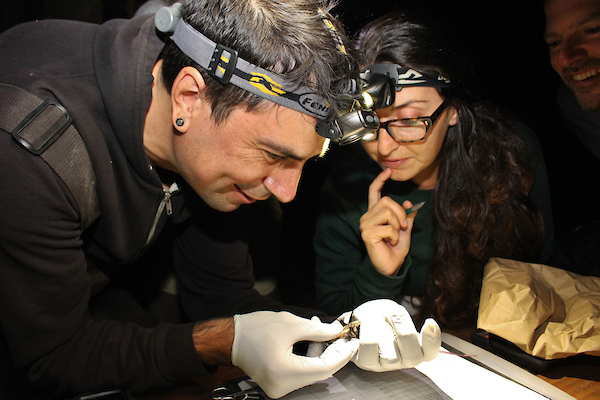Bats are bellwethers of climate change - One Tam is listening closely

By Lexi Pandell for Bay Nature Magazine
On a cool winter night, USGS biologist Gabe Reyes finds a bat stuck in a net. The creature dangles from where its toes and long thumb, which extends like a claw on the top of its wing, are caught in the delicate material. The scene would be concerning—except for the fact that Reyes and his team set up these nets, a couple hours before sunset. Each net is up to 50 by 30 feet wide and so thin that sometimes the human researchers inadvertently walk into them.
Reyes carefully unhooks the bat, pops it in a bag, and carries it back to his research station. There, he’ll identify the species, its approximate age, and whether it’s pregnant or lactating. He’ll swab it to test for the deadly white-nose syndrome fungus. And, perhaps most important, he’ll clip a little tuft of hair from its back to glue on a tiny radio transmitter before releasing it into the night sky.
Now the clock starts ticking. The team needs to track that bat—and they have just two weeks before the device falls off.
This is all part of a One Tam effort to better understand the area’s bat population. Prior to this research, the network didn’t know how many of the 13 species of bats in Marin County frequented the mountain, nor where the bats tended to roost. Bats are notoriously difficult research subjects because they’re nocturnal and researchers need both a rabies shot and specialized equipment to study them. But doing so fills a major gap in One Tam’s understanding of local wildlife. Not only do bats make up 20 percent of the terrestrial mammalian community in these protected lands, but their sensitivity to temperature makes them an indicator species for climate change. Too, the recent California wildfires have prompted increased funding for fuel reduction efforts. If One Tam agencies were to begin removing trees, and other vegetation, they needed to understand where bats were roosting so they could safeguard the populations before such efforts began.
They also sought to monitor potential disease in bat populations. In recent years white-nose syndrome—a fungal infection that kills bats, likely by rousing them during their critical hibernation period so they burn through their energy reserves—had ravaged bat communities on the East Coast; studies in the Sierra pointed to potential cases there too. If white-nose syndrome was making inroads in California, One Tam wanted to know.
NPS secured funding specifically for white-nose syndrome surveillance. Other One Tam partners were able to bring additional money, expertise, and person-power to the effort. William Merkle, supervisory wildlife ecologist for the GGNRA, says such a project might have taken him a year to put together—from project development to staffing to implementation. But One Tam was able to get Reyes on board and have boots on the ground in a few months.
As a first step, in 2017 Reyes coordinated with biologists and other staffers from One Tam agencies to begin acoustic monitoring to capture bats’ echolocation and social calls. In 50 sites randomly selected throughout the One Tam area of focus (see map on p.43), they set up detectors with microphones that turn on between dusk and dawn and are triggered by the high frequency sounds bats emit. Each mic was positioned on a 20-foot flagpole for a week; special audio software helped the team analyze bats’ calls to determine which species was making it.
From the acoustic monitoring alone, they learned that all 13 of Marin’s species were, indeed, in the One Tam area, from the pallid bat with its giant ears and pig nose to the hoary bat with its long frosty mane. Some sites had up to 11 species of bats; some had none at all.
The second part of the research involved tracking down those bats carrying the minuscule radio transmitters during the two-week window before the transmitters fell off. The transmitters don’t provide their GPS location, so One Tam sends out several teams in daytime hours when the bats are asleep. Each pair of researchers sticks a radio antenna outside the car window and drives around until they hear a tracking device beep. As with a metal detector, the beep gets stronger the closer they get to the transmitter. Once they have a clear signal, they hop out of the car and head wherever the bats may lead them, whether that’s on One Tam property or just off it. They have found tagged bats tucked inside eaves of golf course buildings, high in trees, in abandoned buildings, even in the boughs of a tree above a sushi restaurant. Once they track down the bats, the team sets up in that location until sunset, so they can count how many bats emerge from a roost.
So far, Reyes and the One Tam team have found some vibrant bat sites, in eastern Marin near towns, in small parks, and by water treatment plants. They also detected all the rare species they were hoping to find, like the long-eared myotis, which hadn’t been located during previous local monitoring efforts, and they discovered migratory corridors for hoary bats.
Researchers on the East Coast detected white-nose syndrome relatively early in its progression, in part because they regularly track bat sites. Hopefully, no such disease will befall the bats of Marin. But if it does—or if they’re impacted by climate change, fire reduction efforts, or other inevitable change to their habitats over time—One Tam’s research could help local stewards better understand the bioregion and, just maybe, help preserve the bats.
This story was originally published in Bay Nature Magazine in January 2020, as part of the "21st Century Stewardship" section sponsored by the California Landscape Stewardship Network.
About the Author
Lexi Pandell is a writer from Oakland. Her nonfiction work has been published by The Atlantic, The New York Times, WIRED, Condé Nast Traveler, GQ, Playboy, Creative Nonfiction, and others.